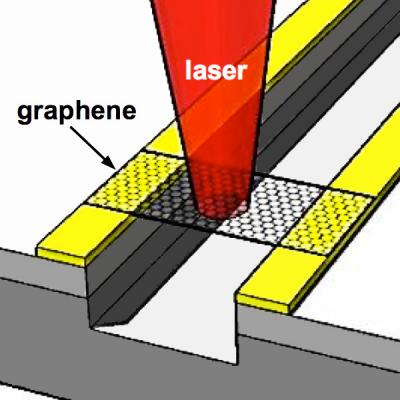A research team comprising Leonhard Prechtel and Leonhard Prechtel from the Technische Universitaet Muenchen’s Walter Schottky Institut has devised a method to improve the time resolution down to the picosecond range for measuring photocurrent in graphene, which in turn helped in detecting pulses in a few picoseconds.
 Photodetectors made from graphene can process and conduct light signals as well as electric signals extremely fast. Within picoseconds the optical stimulation of graphene generates a photocurrent. Until now, none of the available methods were fast enough to measure these processes in graphene. Scientists at the Technische Universitaet Muenchen now developed a method to measure the temporal dynamics of this photo current. Furthermore they discovered that graphene can emit terahertz radiation. (credit:Technische Universitaet Muenchen)
Photodetectors made from graphene can process and conduct light signals as well as electric signals extremely fast. Within picoseconds the optical stimulation of graphene generates a photocurrent. Until now, none of the available methods were fast enough to measure these processes in graphene. Scientists at the Technische Universitaet Muenchen now developed a method to measure the temporal dynamics of this photo current. Furthermore they discovered that graphene can emit terahertz radiation. (credit:Technische Universitaet Muenchen)
This novel method is an answer to quantify graphene’s electronic and optical behavior with respect to time, i.e. the duration between graphene’s electric stimulation and the formation of the corresponding photocurrent. It paves the way to use graphene in designing ultrafast photodetectors.
The core component of the photodetectors under study is freely suspended graphene incorporated into electrical circuits using metallic contacts. The measurement of the photocurrent’s temporal dynamics was done by co-planar strip lines, which were measured utilizing the pump-probe technique, a unique time-resolved laser spectroscopy method. Electrons in graphene are excited by a laser pulse. A second laser is used for monitoring the dynamics of this process.
Through this technique, the researchers accurately monitored the mechanism of photocurrent generation in graphene. Moreover, using their novel method, they discovered that graphene releases terahertz radiation when optically excited. Terahertz radiation lies between microwave radiation and infrared light in the electromagnetic spectrum. Its special feature is its capability to demonstrate the properties of adjacent frequency ranges. It can be packed like a particle radiation but is still capable of piercing matter like electromagnetic waves, thus making it suitable for screening packages, material tests or for some medical applications.